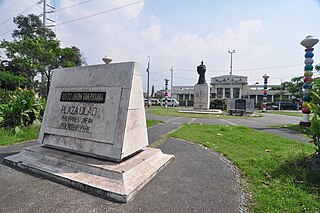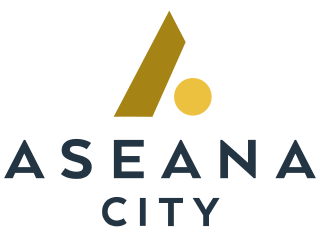
Manila, officially the City of Manila, is the capital and second-most populous city of the Philippines. Located on the eastern shore of Manila Bay on the island of Luzon, it is classified as a highly urbanized city. As of 2019, it is the world's most densely populated city proper. It was the first chartered city in the country, and was designated as such by the Philippine Commission Act No. 183 on July 31, 1901. It became autonomous with the passage of Republic Act No. 409, "The Revised Charter of the City of Manila", on June 18, 1949. Manila is considered to be part of the world's original set of global cities because its commercial networks were the first to extend across the Pacific Ocean and connect Asia with the Spanish Americas through the galleon trade; when this was accomplished, it was the first time an uninterrupted chain of trade routes circling the planet had been established.

Capiz, officially the Province of Capiz, is a province in the Philippines located in the central section of Western Visayas region. Its capital is the city of Roxas. It is located at the northeastern portion of Panay Island, bordering Aklan to the north, Antique to the west, and Iloilo to the south. Capiz faces the Sibuyan Sea to the north.

Epifanio de los Santos Avenue, commonly referred to by its acronym EDSA, is a limited-access circumferential highway around Manila, the capital city of the Philippines. It passes through 6 of Metro Manila's 17 local government units or cities, namely, from north to south, Caloocan, Quezon City, San Juan, Mandaluyong, Makati, and Pasay.

Araneta City, formerly and still commonly known as Araneta Center, is a 35-hectare (86-acre) transit oriented, commercial mixed-use urban development in Quezon City, Philippines. Situated in Barangay Socorro in Cubao, and at the intersection of two major roads, Epifanio de los Santos Avenue (EDSA) and Aurora Boulevard, the area offers retail, dining, entertainment, residential, office, lodging and parking facilities throughout the complex and hosts over 1 million people daily, due to its close proximity to transport terminals, including the railway stations of the MRT Line 3 and the LRT Line 2.

Roxas, officially the City of Roxas, is a 3rd class component city and capital of the province of Capiz, Philippines. According to the 2020 census, it has a population of 179,292 people.

Malate is a district of Manila, Philippines. Together with the district of Ermita, it serves as Manila's center for commerce and tourism.

United Nations station is an elevated Light Rail Transit (LRT) station located on the LRT Line 1 (LRT-1) system in Ermita, Manila. It is situated above the intersection of Taft and United Nations Avenues. The station is named after United Nations Avenue, which in turn is named after the United Nations organization.

SM North EDSA, is a large shopping mall located in Quezon City, Metro Manila, Philippines. It is the first SM Supermall in the country and formerly the largest shopping mall in the Philippines from 2008 to 2011, circa 2014, and from 2015 to 2021.

Ortigas station is an elevated Metro Rail Transit (MRT) station located on the MRT Line 3 (MRT-3) system in the Mandaluyong portion of Ortigas Center. The station is named after either Ortigas Center or Ortigas Avenue, which is nearby.

The Metro Manila Skyway, officially the Metro Manila Skyway System (MMSS) or simply the Skyway, is an elevated highway serving as the main expressway of Metro Manila, Philippines. It connects the North and South Luzon Expressways with access to Ninoy Aquino International Airport via the NAIA Expressway (NAIAX). It is the first fully grade-separated highway in the Philippines and one of the longest elevated highways in the world, with a total length of approximately 39.2 kilometers (24.4 mi).

The Manila Zoo, formally known as the Manila Zoological and Botanical Garden, is a 5.5-hectare (14-acre) zoo located in Malate, Manila, Philippines. First opened on July 25, 1959, it was recently renovated and reopened on November 21, 2022.

Plaza Dilao is a public square in Paco, Manila, bounded by Quirino Avenue to the east, and the rest of the plaza surrounded by the Plaza Dilao Road and Quirino Avenue Extension. The former site of a Spanish colonial era Japanese settlement, it prominently features a memorial commemorating Japanese Roman Catholic kirishitan daimyō Dom Justo Takayama, who settled there in 1615. It is one of two open public spaces in Paco, the other being Paco Park.

Taft Avenue is a major road in the south of Metro Manila. It passes through three cities in the metropolis: Manila, Pasay, and Parañaque. The road was named after the former Governor-General of the Philippines and U.S. President, William Howard Taft; the Philippines was a former commonwealth territory of the United States in the first half of the 20th century. The avenue is a component of National Route 170 (N170), a secondary road in the Philippine highway network, and anchors R-2 of the Manila arterial road network.

United Nations Avenue is a major thoroughfare in Manila, Philippines. A commercial, residential and industrial artery, the avenue runs east–west through the near-center of the city linking Ermita and Rizal Park with the eastern districts. It is home to the World Health Organization Western Pacific headquarters.

Kalaw Avenue is a short stretch of road in the Ermita district of Manila, Philippines. It forms the southern boundary of Rizal Park running east–west from San Marcelino Street to Roxas Boulevard near the center of the city. It begins as a four-lane road at the intersection with San Marcelino widening to an eight-lane divided roadway along the stretch of Rizal Park from Taft Avenue west to Roxas Boulevard. It has a short extension into the reclaimed area of Luneta and Quirino Grandstand as South Drive. The avenue's main section between Taft Avenue and Roxas Boulevard is assigned as National Route 155 (N155) of the Philippine highway network.

President Elpidio Quirino Avenue, more commonly known as Quirino Avenue, is a 6-10 lane divided highway in Manila, Philippines. It runs for 3.6 kilometers (2.2 mi) in a northeast–southwest direction from Nagtahan Bridge across from Santa Mesa in the north to Roxas Boulevard in Malate in the south. It passes through Paco and Pandacan districts where it also serves as a truck route between Port Area and South Luzon Expressway. North of Nagtahan Bridge, the road continues as Nagtahan Street. It is designated as part of Circumferential Road 2.

Aseana City is a 204-hectare (500-acre) mixed-use central business district development located in Parañaque, Metro Manila, Philippines. Owned and developed by D.M. Wenceslao & Associates (DMWAI) through Aseana Holdings, it is situated in the centermost portion of the Central Business Park between the SM business complex in the north and Asiaworld in the south within the Bay City area.

Plaza Moriones is a public square in Intramuros, Manila. Located in front of the entrance to Fort Santiago, it is one of three major plazas in Intramuros, the others being Plaza de Roma located beyond the fort's grounds, and the Plaza de Armas located inside the fort, to which it is often misconstrued for.

Plaza Olivia Salamanca, also known simply as Plaza Salamanca, is a public square in Ermita, Manila, bounded by Taft Avenue to the east, Teodoro M. Kalaw Avenue to the north and General Luna Street to the west. It is dedicated to Olivia Salamanca, one of the Philippines' first female physicians, with a historical marker dedicated to her being installed in 1955.

The Lagusnilad Underpass refers to the pedestrian underpass in Manila, Philippines which connects the Manila City Hall and Intramuros. It also refers to the nearby vehicular underpass where part of the Taft and Padre Burgos Avenues merge.





















